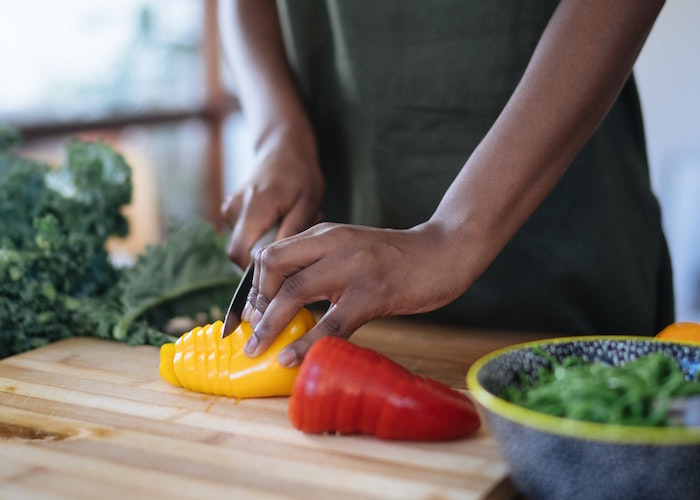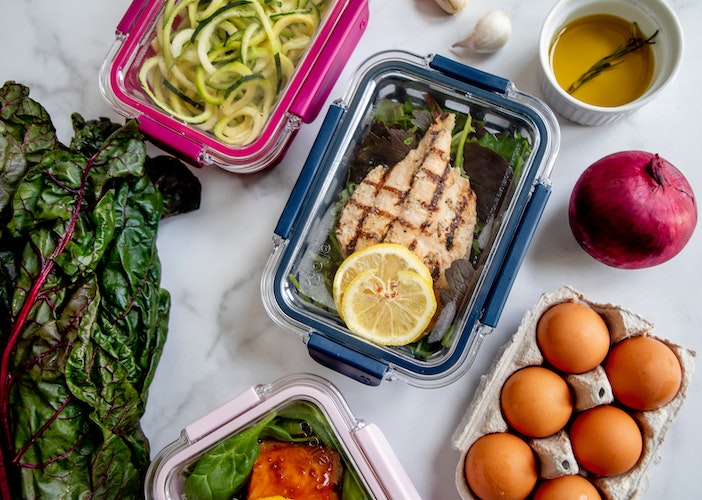The 6 Kitchen Rules This Professional Chef Lives By

As a chef, I’m always looking for ways to decrease food costs at work and at home. But cutting costs on ingredients often means you don’t get a flavorful, balanced meal. This happens in restaurants often, especially when chefs try to make affordable meals for their staff. In an effort to save as much money as possible, they give their restaurant staff the same meal: potatoes, potatoes, and more potatoes.
Similarly, you might have a list of cheap items you always buy at the grocery store but eating the same thing all the time can get boring. On the other hand, trying to mix it up can also lead to a hefty grocery bill. So where’s the middle ground?
I’ve worked in restaurants, catering companies, cafés, and everything in-between, feeding countless guests and staff members, too. Cost and flavor are always top-of-mind, so I want to share some of what I’ve learned with you. The following tips will help you decrease food waste so you can feed yourself and others cheaply without sacrificing flavor. Best of all, I’ve included a couple of recipes to make your life even easier.
1. Frozen food is not the enemy.
Many people think frozen food doesn’t have as many nutrients as fresh food. Fun fact: fruit and vegetables that are frozen while they are still fresh are just as healthy as more expensive fresh options.
I regularly make and freeze fresh fruit compotes and use them a few months later. Rather than buying out of season strawberries in December, I can have just-picked strawberry sauce on my pancakes. It is also important to remember that not everything that you cook freezes well.
Raw or cooked, you can effectively freeze any vegetable or fruit you like — unless it’s water-heavy. Cucumbers, watermelons, or heads of lettuce will form ice crystals then defrost into a messy lump.
2. Bones and veggie scraps? You’ve got soup stock.
Collect everything from carrot tops, chicken bones, onion ends, and any other vegetable waste and throw it in the fridge or freezer until you are ready to use it. I do this all the time and have developed a reputation at work for being a bit of a food hoarder because these scraps make a perfect soup base.
A note on bones: If your bones are raw, roast them in the oven at 450 degrees for 30+ minutes or until they are dark brown but not burnt. Once you are ready, take all your ingredients, cover them in water, and simmer for at least two hours.
3. Use the whole, ugly vegetable.
Think like your grandparents. If you have to spend your hard-earned cash on something, you might as well get your money’s worth. Don’t throw out things like stalks from cauliflower or broccoli, lots of people think that they are not edible, but they are — and they’re delicious! Cauliflower stalks make for a great puree and broccoli stems can be cooked and added to any salad or pasta dish. Get creative with your veggie scraps and look up recipes that include them as ingredients. If nothing else, they make excellent additions to your soup now that you have homemade stock.
Where I work, and at most other restaurants, we tend to only use the nicest-looking pieces of ingredients and throw out the rest. This food is usually perfectly good, so I save it for staff soups and salads. If you are cooking to meet an aesthetic that requires you to make perfect cubes out of round vegetables, you will waste a lot of food.
4. Buy region-specific foods in region-specific stores.
This may sound obvious, but it bears repeating: If you are looking to buy Indian or Lebanese or Chinese foods and spices, go to your local Indian, Lebanese, or Chinese stores.
Spices at larger grocery stores have huge markups. Not only are you more likely to get a better deal on the things you want, but you will also most likely be supporting a small business, too. If I’m making soups for staff with whatever vegetables I have lying around, it’s always helpful to have a couple of spice options on hand. Plus, if you buy too much, you can make spice mixes and give them as gifts!
Note: buying whole spices means you have to dry toast them on the stove yourself. While freshly toasted and ground spices taste great, stick to powdered (pre-toasted) if you want the cooking process to be quicker.
5. Experiment with unfamiliar cuts of meat.
Have you wondered why chefs keep using chicken wings in so many dishes? That’s because they are cheap and delicious. Offcuts and small pieces of meat can also add great flavor to dishes without breaking the bank. Buying lamb bones with a couple of morsels of meat for soup or replacing chicken breasts with thighs or wings will add lots of flavor with a lot less cost.
Use them over the more expensive pieces of meat that you regularly reach for at the supermarket.
6. Stop buying every single kitchen gadget.
Finally, resist the urge to buy kitchen gadgets that look great but can easily be replaced with kitchen tools that you already have. I am 100% guilty of this. I like to hang around kitchen supply stores and legitimize too many purchases, which is even easier for me because of my job.
After more than a few visits I realized I had acquired way too many things. Want a mortar and pestle for all those spices you are going to grind yourself all of twice this year? Use a rolling pin (gently). Lusting over a pastry cutter? A fork will do you just fine. It might not look as nice, but your wallet will thank you.
*****
Finally, below are a couple of my favorite cost-effective recipes that will help you get the most bang for your buck:
Fruit compote
- 2 cups any seasonal fruit
- 1 tbsp sugar
- ½ cup water
Take any seasonal fruit of your choice and slice into bite-size pieces for fast cooking. Use the ones that look a bit rough too (no mold though) because they will be sweet and delicious! Mix fruit with sugar and water and cook at a simmer on medium heat for about 10 minutes. Stir every few minutes until the mixer is no longer too liquid and the compote coats the back of the spoon. Remove from the stove and let cool. The sugar content and viscosity of the compote is at your discretion, I like it to be thinner than jam but more solid than a sauce.
Once it has cooled, decant it into reusable containers and freeze. Make sure you do not add too much in each one, not only will they explode but you want to only use as much as you need, no point in creating more waste. The next time you are craving summer fruits, take out a container and cook until heated through and add it to your favorite breakfast.
Vegetable and peanut soup
This recipe was inspired by a Moroccan peanut soup I had at Trinity Square Cafe in Toronto, Canada. I’ve added my own twist to utilize food scraps so I can make it at work for staff dinners. Think of this recipe as an outline — you can add or replace vegetables relative to what you have in the fridge, especially if they are about to go bad.
- 1 tbsp cooking oil
- 1 medium onion
- diced 3 cloves garlic
- minced 2 cups of your preferred vegetables, chopped 2 cups homemade stock (see Tip #2)
- 1 28 oz. tin of tomatoes
- ¼ cup peanut butter (either with little or no sugar)
- 1 tbsp ground cumin
- 2 tsp ground coriander
- 1 pinch of cinnamon
- ¼ tsp chili powder
- Salt and pepper to taste
Add cooking oil to a warm saucepan set to medium heat. I recommend using canola or grapeseed oil as olive oil has a low smoke point. Not only that but it is really expensive, and cooking it means the taste doesn’t really come through in the end. If you want to use olive oil, it works best as a finishing oil for flavor.
Once the oil has heated through, add diced onions and sauté until translucent, about 5 minutes. Add garlic and cook for another 5 to 10 minutes until the smell of raw garlic is gone and it starts to become aromatic. You may want to lower the heat slightly or add a bit of water if things are browning too quickly. Avoid burning the garlic!
Next, add your mixed vegetables. These can be anything you want, whether it’s frozen peas, carrots fresh from the market, or cauliflower stalks that you have been saving for a couple of days. Cook everything for 10 minutes until softened and slightly browned. Add your tin of tomatoes and homemade soup stock and simmer for 15-20 minutes or until your vegetables are cooked through. Add your peanut butter and spices, stir until everything is well distributed, and remove from heat.
Once your soup has cooled slightly, blend until it is nice and smooth. If you do not want to blend it just make sure you have cut your vegetables into small enough pieces. Eat immediately or freeze in serving-size containers for another day. Makes 4 servings.
Gemma has worked in restaurants in Canada and the United Kingdom and currently lives in Toronto. She has had many lives as a chef, an artist, and an urban planner, creating A Failed Chef to record her misadventures and discoveries in kitchens at work and at home.
Image via Pexels
Like this story? Follow The Financial Diet on Facebook, Instagram, and Twitter for daily tips and inspiration, and sign up for our email newsletter here.




